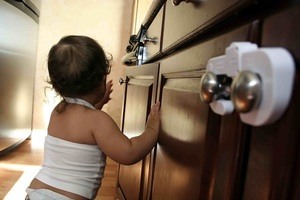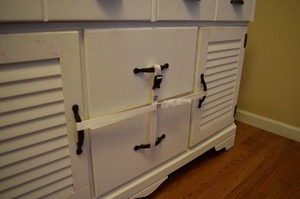How To Baby Proof Drawers

Babies seem to grow at a rapid pace, and before you know it your little bundle of joy has soon become an inquisitive toddler that wants to explore every inch of your house. And, amongst the most irresistible places to discover new and exciting objects are your drawers.
Drawers are places that harmful objects can be lurking, though. Not to mention, they can be pretty dangerous themselves, and a trapped finger in a drawer can cause a great deal of pain on a tiny hand.

Toddlers have also been known to use drawers in a stepladder fashion to get to the top of a chest, and this is where the real danger lies. One wrong foot and the entire piece of furniture could come crashing down, causing a potentially fatal accident.
This is why, as your child begins finding their feet and becomes eager to learn more about their surroundings, it’s incredibly important to make sure that all of the drawers in your house have been baby-proofed. But what’s the best way to do it?
Below, we’ve put together a simple guide to help you learn how to baby proof drawers. This will help keep your child as safe as they investigate each room of your house, and will prevent any accidents or injuries befalling your little one.
Remove Any Dangerous Items
The first thing you need to do when you’re baby proofing your drawers is to go through each one and take out anything that could cause an injury if your child does manage to get into them.
Put yourself into the mindset of a toddler. They don’t understand danger and, as such, they may pick up something that could cause them to injure themselves. If you think ‘Is this a dangerous object?’, the chances are that it most likely is. Never second guess yourself, it’s always better to be safe than sorry after all.
Take a look at the list below for just a few of the items that you’ll want to remove from your drawers.
- Sharp knives
- Cutlery
- Medication
- Batteries
- Tools such as screwdrivers and hammers
- Cleaning detergents and laundry pods
- Long corded appliances
Once you’ve removed these items from your drawers, you’ll need to find a safe space to keep them. We would recommend either storing them in an overhanging kitchen cupboard where they will be safely out of reach, or placing them into a lockable storage box.
Find the best babyproofing products for your individual needs
There are a plethora of babyproofing products available to choose from, however, no two households are ever the same. So, what may work best for some people may not be the best option for the style or design of your drawers.
If your drawers are fairly easy to open, you might want to try going for latch-style baby locks. These require a little drilling into the cupboards themselves to install, but once they are in place it’s nearly impossible for curious little fingers to get inside and see what wonders the drawers hold.
Magnetic locks are also a good option and are usually available with a self-adhesive backing, which means you won’t have to worry about drilling into your drawers. Once installed, the strong magnetic connection keeps the drawers firmly shut, and you’re toddler is unlikely to have the strength it takes to break the connection.
Some magnetic locks also come with a special key that can be placed on the drawer or cupboard when you need access and is the only way to break the magnetic bond. This is especially useful if you’d like to keep the contents of your drawers secure as your child grows into a young child.
The DIY Option

If you’d prefer not to spend too much money babyproofing your drawers, there is a homemade solution you can go for. This won’t only save you money, but will also prevent you from having to drill into your furniture to install babyproof locks.
It does, however, only work on drawers that have handles you can put something through. It’s an extremely simple set up and only requires you to run a thin piece of wood or a curtain rail through all the handles from top to bottom.
Push everything into place and you’ll have a secure connection with the floor, while all the drawers remain firmly locked.
This method isn’t without its downsides, though. For example, when you need access to a drawer yourself, you’ll need to remove the entire piece of wood and rethread it each time. You also run the risk of your toddler learning this process and eventually copying you to gain access to the drawers.
Furniture Anchors
It doesn’t take too long for a toddler to realize that a series of drawers pulled out at separate intervals looks a lot like a staircase. But one inquisitive step onto a drawer and an entire cabinet can easily come tumbling forwards, potentially causing serious harm to your child.
To prevent this awful situation from happening, it’s also a good idea to anchor any furniture that has drawers firmly to the wall as well.
There are special kits you can buy that have everything you need in them to do this, and it’s usually a fairly straightforward installation process. One fixture will be attached to the back of your cabinet, with another fixture installed to the wall it’s placed against. A metal chain or cord is threaded between the two, and a stable, tip-proof connection is established.
Keep an eye on your child
Of course, the most important thing to do when your toddler has found their feet and begins exploring is to keep an eye on them as much as you can. No babyproofing solution can rival actual supervision, and keeping them out of danger is a real responsibility.
Keeping a watchful eye is easier said than done, however, especially in households with multiple young children. This is why babyproofing your drawers and ensuring your cabinets are kept securely anchored to a wall is one of the most important things you’ll ever do as a parent.

